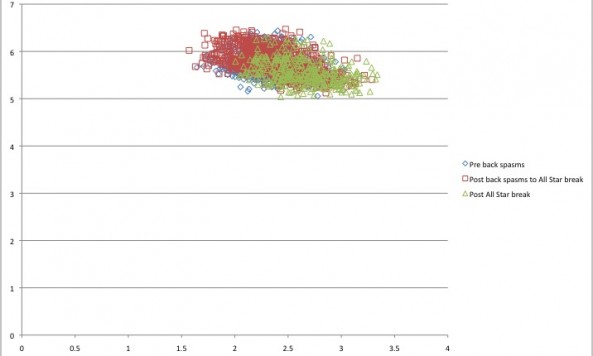Erik Bedard’s first (and let’s be honest, probably only) season as a Pirate has been a bit of a roller coaster. He started out the season on a tear. In his first six starts, he struck out 37 hitters in 34 innings, he walked 14 (9.8 K/9, 2.6 K/BB), and he put up a 2.65 ERA. The Pirates were only 2-4 in those six starts, but that was more a function of a team that couldn’t score runs than it was a function of Bedard pitching poorly; in his first four starts he gave up just eight runs and lost all four of them because the Pirates only scored a total of three runs across the four games.
On May 9th he threw five pitches, finished the first inning, and left the game with back spasms. He didn’t really miss a start — the Pirates juggled the rotation a bit to give him extra rest but that was it — but he was clearly affected by the spasms. In his next ten starts he only threw 51 1/3 innings. He struck out 41 hitters in that span (7.2 K/9) and walked 25 (1.6 K/BB). His ERA was 6.31 and in his last two starts before the break, he failed to make it out of the fifth inning and fourth inning, respectively. He swore nothing was wrong with his back, but the Pirates’ coaching staff shuffled the rotation to give him a long All-Star break (he didn’t pitch at all from July 7th to July 16th) and they worked on his mechanics. Whatever they changed seems to have made a difference. In four starts since the break, Bedard’s struck out 27 in 25 innings (9.7 K/9) against eight walks (3.4 K/BB) and his ERA is 3.60, even with his ugly start at Wrigley last week (he gave up eight runs in 4 1/3, mostly because of two three-run homers). So what’s different?
Let’s start where we always start; with the PitchFX break chart (all of the PitchFX data in this post comes from Brooks Baseball).

It’s hard to see much of a difference pre-back spasms and post-spasms, really, but it does seem like after the All-Star break Bedard has been leaning more heavily on his two-seamer and less heavily on his four-seamer (look at the ‘spin deflection’ chart on this page with the different pitches mapped out and then flip it because Bedard is a lefty). It’s a small sample, but the numbers do bear that out. This is actually a trend that’s been evolving throughout the year, though. Bedard threw more four-seamers than two-seamers in April and May and more two-seamers than four-seamers in June and July. That doesn’t break down along performance lines at all, so I don’t think that’s our solution. It also looks like he threw a ton of four-seamers last night, in what was almost certainly his best mix of both stuff and efficiency all year. I don’t think our answer lies here.
What about release point?

This is a little more interesting. Bedard’s pre and post back spasm scatters overlap almost completely, but since the All-Star break it looks like he’s either dropped his arm slot and focused on being more consistent with his release point. Compare his release points from his July 1st start against the Cardinals (100 pitches in 4 2/3 innings, eight hits, five runs, five strikeouts, two walks) with last night. Against the Cardinals it looks like he was throwing from two different arm slots; one over the top and one closer to a three-quarters delivery. Last night, he pitched almost exclusively from the three-quarters slot.
What’s interesting to me here is that on both charts, there’s almost no difference in Bedard before his back spasms and after his back spasms but before the All Star break, but there is a difference post-All Star break. That means that I think we’ve picked a false inflection point; that we’ve assumed that the correlation between leaving a start early with back problems and his struggles implied causation. We were wrong. Something else happened.
On a hunch, I put all of his pre-All Star break pitches into one chart, then separated the curveballs out. Here’s what that looks like: 
Almost all of the high-release point pitches Bedard was throwing before the All-Star break were curveballs. My guess is he was getting on top of the curve to get more snap on it and in doing so, he was inadvertantly tipping his own pitches. The National League, which had never seen him before, took a few starts to figure him out, but when they did his effectiveness was pretty seriously decreased. Over the break, the Pirates worked with him on correcting this and they’ve obviously done a good job of it. The Cubs saw Bedard pre-Break and even though he beat them, he didn’t pitch all that well, walking four and striking out just three in six innings. They saw him twice in a row after the All-Star break and even though they hit him hard the second time through, he struck out 18 Cubs in 11 1/3 innings. I’m guessing that’s because they thought they had him figured out and he changed the release point on his curve a bit, which left them pretty hilariously off-balance for most of both games.
This is something that definitely bears watching going forward, because I don’t know how it compares to Bedard’s mechanics in the past (ie, is he now throwing his curveball differently than he has over his entire career?). At least in the short term, though, it looks to me like we can chalk up another victory for Ray Searage and his coaching staff.




















